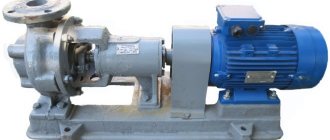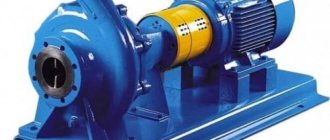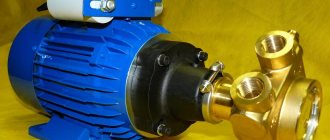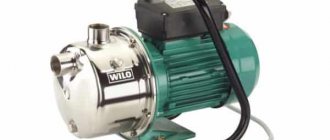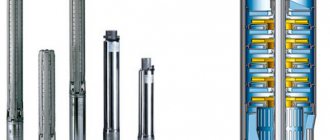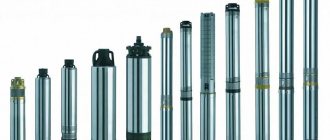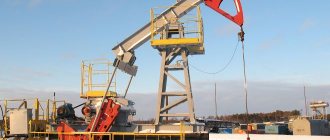| Place | Name | Characteristics in the rating |
| Best Conventional Surface Pumps |
| 1 | Grundfos MQ 3-35 | Best technical characteristics |
| 2 | Kraton PWP-370 | Best price. Reliable brand |
| 3 | GILEX Jumbo 60/35 N-K | Operates at 1°C |
| 4 | SPERONI KPM 50 | High build quality |
| The best circulation pumps for heating |
| 1 | Grundfos UPA 15-90 | The most popular circulation pump for heating |
| 2 | VORTEX TsN-32-4 | The best ratio of price and quality |
| 3 | UNIPUMP LPA 25-60 | Convenient setup. Electronic scoreboard |
| 4 | JEMIX WRF 50/16 | The most powerful pump |
| The best sewer installations |
| 1 | WATERSTRY WFM 7-8 | Best pump with grinder |
| 2 | Grundfos Sololift 2 C-3 | High throughput |
| 3 | Makita PF1010 | Highest quality |
| 4 | CNP 50WQ 8-15-1.1 | Powerful high flow pump |
| The best pumping stations |
| 1 | GILEX Jumbo 50/28 Ch-14 | Best price |
| 2 | DENZEL PSD800C | Maximum head (45 m) |
| 3 | VORTEX ASV-1200/24N | Reliability and durability |
| 4 | GARDENA 3000/4 Classic | Compact form factor |
Best Conventional Surface Pumps
Conventional surface pumps are installed outside the source, connecting the device to it using a conventional hose. In case of year-round use of the pump, it is necessary to provide protection for the housing from low temperatures, since water frozen inside the working cavity can lead to breakdown. Typically, the power of a household surface pump is designed to pump water from a depth of up to 10 meters. The advantages of such devices are simple installation, primitive design and high mobility.
Additional items
In order for the pump, which pumps water from wells of various depths, to function normally for a long time, it must be equipped with additional technical devices. In particular, if the water pumped out using such a pump contains a large amount of sand and other foreign matter, it is not recommended to avoid using filters. The use of filters allows you to protect the internal parts of pumping equipment from mechanical damage and premature wear.
In addition to coarse filters, an external or surface pump requires other elements of additional equipment, which, in particular, include:
- a flexible hose or metal pipe through which the pumped liquid medium will rise to the surface;
- electrical machines with which pumping equipment will be connected to the power supply network;
- a check valve that will prevent the pumped liquid from returning back into the well, which will protect the pump from such a negative phenomenon as idling.
Complete wiring diagram for connecting a surface pump
List of equipment and components
In addition, surface pumps for wells are equipped with float-type switches, with the help of which the operation of such equipment can be made automatic. The use of float switches allows the submersible pump to turn on without your participation at the moment when the water level in the well reaches the maximum permissible value, and turn off independently when the water in the underground source becomes too low.
Due to the peculiarities of its design, surface-type pumping equipment should be operated in a place well protected from high humidity. In particular, a specially prepared site or pit located in the immediate vicinity of the well shaft can be used as such a place.
The best circulation pumps for heating
Heating circulation pumps are used to force water circulation in a circle. The devices can also work with hot water, since their main area of application is heating systems. The devices create pressure differences that help the fluid overcome the resistance created in the pipe. When choosing a circulation pump, you should pay attention to the pressure created, which determines how large systems the device can serve, productivity and the maximum water temperature with which the device can operate.
The leader in terms of sales of surface circulation pumps is . Grundfos
is a Danish concern, the most popular and reputable company for the production of pumping units. The production volume is more than 16 million products per year. The company's head office is located in Denmark, and its main production facilities are located in Germany. Therefore, Grundfos pumps are often called German, as evidenced by the high build quality. In 2005, a plant for the production of Grundfos pumps was opened in Russia (Moscow region).
What other tubular heating radiators are worth paying attention to?
Whirlwind PN-900CHE 68/4/7
Whirlwind PN-900CHE 68/4/7. Photo: yandex.market.ru
The centrifugal pump is equipped with an external ejector, due to which the water supply depth reaches a record 30 m. The same device reduces the requirements for the purity of water and the amount of air dissolved in it. The handle and stable legs are curved from a single pipe.
Characteristics
| Performance | 4.8 cubic meters/hour |
| Pressure | 35 m |
| Suction depth | 30 m |
| Power | 900 W |
Advantages and disadvantages
Cast iron body; low noise level
Customers report ejector malfunctions
show more
SFA SANITOP
SFA SANITOP. Photo: yandex.market.ru
This surface pump is capable of not only supplying clean water, but also removing dirty water. Domestic wastewater is a serious problem, but the circulation unit copes with it perfectly. Its design contributes to this. The impeller is made of cast iron, the body is made of durable plastic. The pump is equipped with a food waste chopper with a steel blade. There are two wastewater connection points. You can simultaneously connect the house sewer system and the street septic tank to them. The automatic system turns off the engine at idle, and a float sensor monitors the liquid level in the containers.
Characteristics
| Performance | 6.6 cubic meters/hour |
| Pressure | 5 m |
| Noise level | 46 dB |
| Power | 400 W |
Advantages and disadvantages
High performance; high-quality materials and assembly; ease of operation; two connection points
High price
show more
RYOBI ONE+ R18TP-0
RYOBI ONE+ R18TP-0. Photo: yandex.market.ru
Autonomous pump powered by battery. Pumps up to 1000 liters of water on one charge. Can work for irrigation, pumping water from a pool or barrel. The model is part of the ONE+ series, unique in that up to one hundred tools can be powered from a removable battery. Supplied without a battery; in addition to the pump, you need to buy a battery and a charger.
Characteristics
| Suction depth | 2.5 m |
| Performance | 1.5 cubic meters/hour |
| Pressure | 14 m |
| Maximum water temperature | 80°C |
| Power | 140 W |
Advantages and disadvantages
Battery powered; protection against jamming and dry running; low noise level
Shallow suction depth
show more
Bison MASTER M1 NS-M1-800
Bison MASTER M1 NS-M1-800. Photo: yandex.market.ru
The universal circulation pump does an excellent job of irrigation, water supply, increasing pressure in the water supply or heating system, and supplying clean water from the pond. Equipped with overheating protection.
Characteristics
| Performance | 3.6 cubic meters/hour |
| Pressure | 40 m |
| Suction depth | 8 m |
| Supply voltage | 220 V |
| Power | 800 W |
Advantages and disadvantages
Reliability; overheat protection; ergonomic carrying handle. quality materials and workmanship
Not detected
show more
Selecting a unit taking into account well parameters and required pressure
One of the main factors to consider when choosing a surface equipment model is the diameter of the well.
If the water supply source is not yet ready, the owner can get advice from specialists who will drill it. When choosing equipment, it is worth taking into account the quality of water and the presence of solids in its composition. Such inclusions can only be pumped with a pump equipped with a coarse filter. This factor will significantly reduce the risk of equipment malfunctions and malfunctions.
Expert opinion
Kuznetsov Vasily Stepanovich
If the built-in filter is not included in the package, then it must be installed.
Another factor to consider when choosing a surface unit for a well is the maximum fluid pressure that the pump can handle. This value is measured in bars and is indicated in the technical document.
To determine the required maximum pressure, add the number 30 to the well depth, and then add another 10%.
Rating of surface units for dirty water
- Pedrollo D20
– the model has a head height of 27 m and a capacity of 20 m3/hour. - Grunfos Unilift CC 9 A1
– this model has a head height of 9 m, pumps a volume of 14 m3/hour. - Grunfos Unilift CC 5 A1
is a budget option with a head height of 5 m and a productivity of 6 m3/hour.
Surface equipment for dirty water is used for:
- drainage and pumping of dirty water from sewer basements, cellars during natural disasters and floods;
- drainage of artificial water sources, fountains, canals;
- pumping water from a drainage well for irrigation of garden plantings.
- These units are self-priming.
- The size of particles that the filter does not allow through is 1.0-1.5 cm.
- Operating temperature range: –10˚С – +90˚С.
Advantages:
- Regardless of density, screw units handle sludge well.
- Diaphragm pump models can work with large particles (up to 50 mm), if the concentration of such inclusions is no more than 50%.
The devices operate from a gasoline or electric drive.
Flaws:
- low lifting heights;
- loud noise during operation;
- You will need to place the suction hoses correctly.
Rating of surface units for hot water
- CNS (G)
- the line of units refers to multistage pumps. The water temperature range is from 45 degrees (CNS) to 105 degrees (CNSG). Pressure indicators – 44-220 m, liquid supply – 38 m3/h. - WILO Yonos
- the household model has a “wet” rotor, which provides a lifting height of 7 m and an adjustable power level. - WILO VeroTwin
– model with a “dry” rotor, index DR-E, temperature range – 120 degrees at high pressure.
Circulating units are used to pump hot liquid. The heating and hot water supply system will require a closed circuit.
Many pumps are made of high-quality cast iron, and the insulating elements are made of ceramics or elastic materials.
For pumps with a “wet” rotor, the coolant is moving water.
And equipment with a “dry” rotor has an isolated power part from the movable pressure mechanism.
Advantages:
- Pumps with a “wet” rotor are characterized by smooth pressure control, reliable operation and low noise.
- Equipment with a dry rotor has an efficiency of up to 80% and high productivity.
Flaws:
- Inexpensive pumps have an efficiency of no more than 50%.
- Expensive equipment requires periodic maintenance.
Surface pumping stations
Wells of considerable depth can also be equipped with surface-type pumps, but in such cases the pumping equipment must have high power. It should be kept in mind that its cost is quite high. The set of such equipment, in addition to the surface pump itself, includes a hydraulic accumulator and a number of other additional equipment elements. Meanwhile, surface-type pumps are advisable to use in cases where the depth of the well from which water must be pumped does not exceed 20 meters. If the depth of the underground water supply source is greater than this indicator, it is better to use submersible pumping equipment to service it.
In the event that a surface pump is needed to pump water from a well that is characterized by a high content of sand, then such equipment must be used in conjunction not only with a filter, but also with a special sump.
Surface self-priming pumping station
Before selecting an external pump to equip a well, you need to accurately determine the purpose of using such equipment. For servicing shallow wells, an inexpensive pump model with low power is quite suitable. To pump water from wells of considerable depth, you will have to purchase more expensive equipment, as well as equip it with a number of additional technical devices.
The modern market offers a wide variety of surface pumps from both foreign and domestic manufacturers, which allows you to select such equipment in accordance with specific tasks. Consultations with representatives of trading companies involved in the sale of such pumps, as well as user reviews that are easy to find on the Internet, will allow you to make the right choice.
Rating of household surface equipment
- Aquario ARM-100
- this model has excellent efficiency and a long service life with minimal characteristics. - Gilex Jumbo 60/35 HK
- pump, consuming 600 W, produces a pressure of up to 35 m. - Wilo PB-088EA
- the unit has a power consumption of 140 W, but a head of 9 m.
Two types of units are used:
- single-stage centrifugal pumps;
- multistage centrifugal pumps.
The design is selected taking into account the performance characteristics and scope of use.
Characteristics:
- Compact drive, ensuring low noise level during operation.
- Fluid consumption. Maximum performance – 70 l/min.
- Fluid pressure (maximum) – 17 m.
- Minimum power – from 500 W.
Advantages:
- long continuous operation;
- ease of installation;
- affordable price;
- small dimensions.
Minuses:
- liquid suction height 7-9 m;
- pumping distance – 17-42 m.
Rating of surface fecal equipment
- Grundfos Liftaway B
- universal model flows up to 100 l/min, temperature range 50-70°C. - Wilo DrainLift Box
is a powerful model, flows up to 300 liters per minute with a power of no more than 600 W. - DAB Fecalift 200
is a productive model for cold wastewater, pumps out up to 70 liters per minute, power up to 65 W.
A type of equipment for pumping dirty liquids is fecal stations. Their difference from pumps:
- powerful engine;
- there is a filter element or a grinding device;
- equipped with float switches.
There are restrictions on the operation of these pumps:
- low suction height – from 1 meter;
- at low power the pump operates ineffectively;
- Due to high load, units often break down.
How to choose surface water equipment
Main parameters:
- Depth of water rise. Measure the distance from the suction pipe to the surface of the liquid surface.
- Pressure The parameter indicates the maximum water transmission range. The length of the water supply pipes or irrigation system is taken into account.
- Engine power. With increasing power, the pressure and lifting depth increase.
- Electrical energy consumption.
- Material. Only high-quality components (bearings, blades) will withstand intense work.
- Noisy running pump.
- Safety. The parameters include: ease of installation, tightness, quality of pump assembly.
- Service maintenance. If there is no service center in the region to service the selected model, then difficulties will arise with warranty repairs in the event of a breakdown and with the purchase of spare parts.
Secondary parameters:
- Brand name. You don’t have to overpay for a well-known name. There are several well-known brand companies in the segment of surface pumps, but only new manufacturers have proven themselves well.
- Price. You need to choose a pump based on balanced characteristics.
Rating of self-priming surface units
- Grundfus JP
- the model has a head of up to 48 m, and a lifting height of up to 8 meters. - Wili PB-201 EA
– water supply range – 35 m, its lift from 8 meters. - Pedrollo CKM 50
– the model has a pumped liquid volume of up to 2.4 m3/hour.
The rise of liquid in all units begins after preliminary filling of the suction pipeline. Self-absorption occurs during further work.
Application area:
- providing residential buildings and other buildings with water;
- Irrigation of the site, provision of watering systems;
- filling swimming pools with water;
- pumping out water.
Advantages:
- reliability and simplicity of design;
- pumps do not depend on the nature of water;
- low noise level;
- minimal maintenance costs.
Flaws:
The weak point is the low lifting height. The performance can be improved by replacing the pump model with a submersible unit.
✦ This is also interesting: Our rating: TOP best garden pumps for watering the garden
Unit design
To understand the operating principle of this brand of unit, you need to understand its structure. From the name itself it already becomes clear that the surface pump is not lowered into the water, but is installed somewhere on the surface of the earth, not far from the hydraulic structure from which the water is drawn. Water is pumped using the self-suction method through a hose inserted into the water (this can be a hose or pipe). That is why the depth of water intake from surface pumps is not very large – it does not exceed 10 m.
This, in principle, is enough, because outside the city, in summer cottages, owners rarely use artesian wells with a depth of more than 50 m. More often, wells or sand wells with a depth of up to 20 m are used for this purpose. It would seem that for such wells a surface unit is not the best the best option, but today engineers have overcome this problem too. You can install an ejector in the well, which increases the depth of water intake to 50 m.
True, for the ejector you will have to use a two-pipe system, and therefore a completely different model. It has two pipes that are connected to pipes going into the wellbore. And one pipe that pumps water further into the home plumbing system. In principle, these are the main differences that divide the surface pump for water wells into two groups. Otherwise it is the same centrifugal type design.
It was centrifugal force that replaced human muscle power, although many summer residents still use a hand pump for a well. It can be considered the predecessor of surface-type pumps - the intake mechanism is located on the surface of the earth, and water is pumped out through a hose. The addition of an electric mechanism to the hand pump allowed it to evolve into a surface pump. However, even such a primitive device has an undeniable advantage over modern analogues - the absence of the need for electricity.
With ejector
General Features
A few words about what all models of surface pumps have in common.
- Versatility. This indicator is mainly determined by the possibility of laying a suction hose into the shaft of a hydraulic structure. If we talk about well pumps, then when choosing the unit itself, its diameter must be taken into account. Because the device must easily enter the well without touching its walls. The surface pump is not installed in the shaft; only the hose is lowered there. And it can be of minimal size, and it will be smaller than the minimum size of the casing pipe.
- Compared to submersible analogues, surface ones are more powerful, and their efficiency is higher.
- And the most unfortunate thing about these devices is the shallow suction depth of water.
- Again, comparing them with deep ones, it can be noted that there is no talk of 100% sealing of the housing here. In principle, it is not needed, because the equipment does not go into the water. The only thing you need to pay attention to during operation is to create conditions for the pump to operate in a dry place.
- Small dimensions and, accordingly, low weight of the product.
Basement installation
Attention! The main requirement for the operation of surface self-priming pumps for wells is its installation in a room where the temperature is always positive and does not drop below +5C.
But according to reviews from a large number of consumers who have already had experience using both borehole and surface pumps, what is attractive to everyone is that the unit is installed on the surface. This is understandable, because in this way the pump is under supervision at all times. It is easier to maintain and repair. On the other hand, if local water supply is used only in the warm season, then the pump itself can be easily dismantled, placed in a closed room, and installed again in the spring. And all this will take literally an hour at most.
